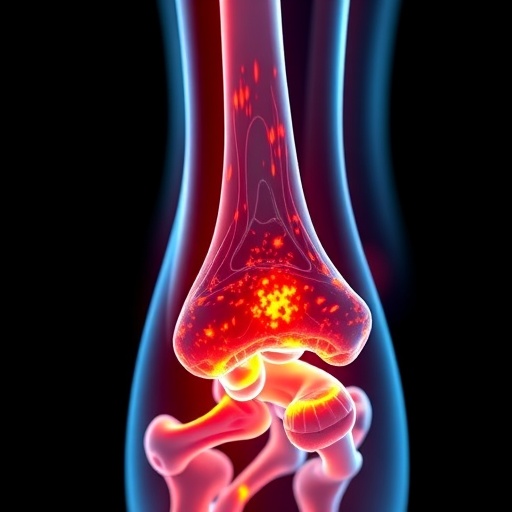In a groundbreaking advancement poised to redefine regenerative medicine, researchers in South Korea have engineered a novel nanoparticle-stem cell hybrid technology that significantly enhances three-dimensional (3D) bone tissue regeneration. This pioneering development promises not only to revolutionize the treatment of bone fractures and skeletal injuries but also to open new frontiers in bioengineering and therapeutic applications.
The research was spearheaded by Dr. Ki Young Kim and her team at the Korea Research Institute of Chemical Technology (KRICT) in collaboration with Professor Laura Ha at Sunmoon University. Their innovative approach involved the creation of a ‘nanobiohybrid’—a synergistic assembly integrating mesoporous silica nanoparticles (mSiO₂ NPs) directly with human adipose-derived mesenchymal stem cells (hADMSCs). This integration transformed traditional stem cell spheroids into advanced structural units with superior osteogenic potential, capable of regenerating bone tissue with unprecedented efficiency.
Mesenchymal stem cells (MSCs) are known for their ability to differentiate into various cell types including osteoblasts, the bone-forming cells critical to skeletal repair. However, traditional 3D stem cell aggregates, such as spheroids and organoids, have long faced challenges including core cell death and inconsistent differentiation, primarily due to inadequate nutrient and oxygen transport within their structure. This limitation has constrained their clinical applicability for bone repair and drug screening.
Addressing these challenges, the research team adopted a novel strategy wherein mesoporous silica nanoparticles were methodically coated onto the surface of stem cells. This nanoparticle layer acts not only as a structural scaffold that promotes the stable interconnection of cells into densely woven spherical clusters but also as a controlled delivery system for osteoinductive biomolecules. These biomolecules are gradually released from the nanoparticles, delivering localized stimuli that direct stem cells towards uniform osteogenic differentiation.
Extensive in vitro evaluations revealed that these nanobiohybrid spheroids exhibited markedly enhanced cell viability compared to conventional stem cell spheroids lacking nanoparticle integration. Additionally, the osteogenic differentiation within these hybrid clusters was more uniform, an essential feature for consistent and effective bone tissue formation. Such uniformity is critical for ensuring the functional integrity and mechanical robustness of regenerated bone.
To validate the practical therapeutic implications of their design, the team employed a mouse calvarial defect model, a widely used preclinical platform for assessing bone regeneration. Within six weeks of implantation, the nanobiohybrid spheroids facilitated regeneration of about 36% of the bone defect area, demonstrating a remarkable improvement—approximately 1.3 times greater—over spheroids composed solely of stem cells. This quantifiable enhancement underscores the significant potential of nanoparticle integration to augment stem cell-based regenerative therapies.
Central to the success of this methodology is the dual functionality of the mesoporous silica nanoparticles. Their porous architecture supports extensive loading and gradual release of osteogenic biomolecules such as growth factors, offering a sustained microenvironment conducive to bone formation. Moreover, as structural elements woven within the cell aggregates, these nanoparticles provide mechanical cues that may further influence cellular behavior and differentiation pathways.
The implications of this research extend far beyond bone tissue engineering. Dr. Ki Young Kim envisions the adaptability of this technology to other complex tissues including cartilage and skin, which share similar challenges of uniform cell differentiation and tissue formation. The modularity of nanoparticle functionalization and stem cell assembly hints at a versatile platform capable of addressing a broad spectrum of regenerative medicine needs.
While the current study remains at the preclinical stage involving small animal models, the promising results lay the foundation for future validation in large animal models and clinical trials. The researchers anticipate that with further optimization, this platform could evolve into customizable, patient-specific bone grafts, tailored to individual regenerative requirements and enhancing therapeutic outcomes.
KRICT President Dr. Young-Kuk Lee emphasized the societal impact of this innovation, particularly in the context of rapidly aging populations. “We hope that our stem-cell-based regenerative technology will help improve treatments for bone fracture patients in an aging society,” he stated, highlighting the urgent need for advanced therapeutic modalities that can restore quality of life among elderly individuals.
This study not only advances scientific understanding but also reflects the growing synergy between nanotechnology and stem cell biology. By intricately weaving nanoparticles with stem cells, the researchers have engineered living building blocks that harness both biological potential and nanomaterial functionality—a transformative paradigm in tissue engineering.
Funding and support for this research were provided by KRICT’s Basic Research Program, the National Research Foundation of Korea (NRF) under the Ministry of Science and ICT, and the Excellent Company Research Center Program administered by the Ministry of Trade, Industry and Energy. Such multi-agency collaboration underscores the strategic national emphasis placed on chemical and biomedical innovation.
The full details of this influential research were published in the August 2025 issue of ACS Biomaterials Science & Engineering, a reputable journal with a notable impact factor of 5.5. The publication credits Dr. Ki Young Kim as the corresponding author, alongside first author Professor Laura Ha, recognizing their leadership in this cutting-edge project.
As the landscape of regenerative medicine continues to evolve, this advancement presents a compelling blueprint for integrating nanotechnology with stem cell therapeutics. The design principles and empirical validations described herein are expected to catalyze new research avenues, ultimately transforming patient care across a spectrum of degenerative and traumatic disorders.
Subject of Research: Enhancement of bone regeneration using nanoparticle-assembled stem cell spheroids.
Article Title: Nanoparticle-Woven Stem Cells as Innovative Building Blocks for Enhanced Bone Regeneration.
News Publication Date: 25 August 2025.
Web References:
DOI link to article
Image Credits: Korea Research Institute of Chemical Technology (KRICT)
Keywords: Nanoparticles, Stem Cells, Bone Regeneration, Mesoporous Silica Nanoparticles, Osteogenic Differentiation, Tissue Engineering, 3D Spheroids, Regenerative Medicine, Nanobiohybrid, Mesenchymal Stem Cells, Calvarial Defect Model.




